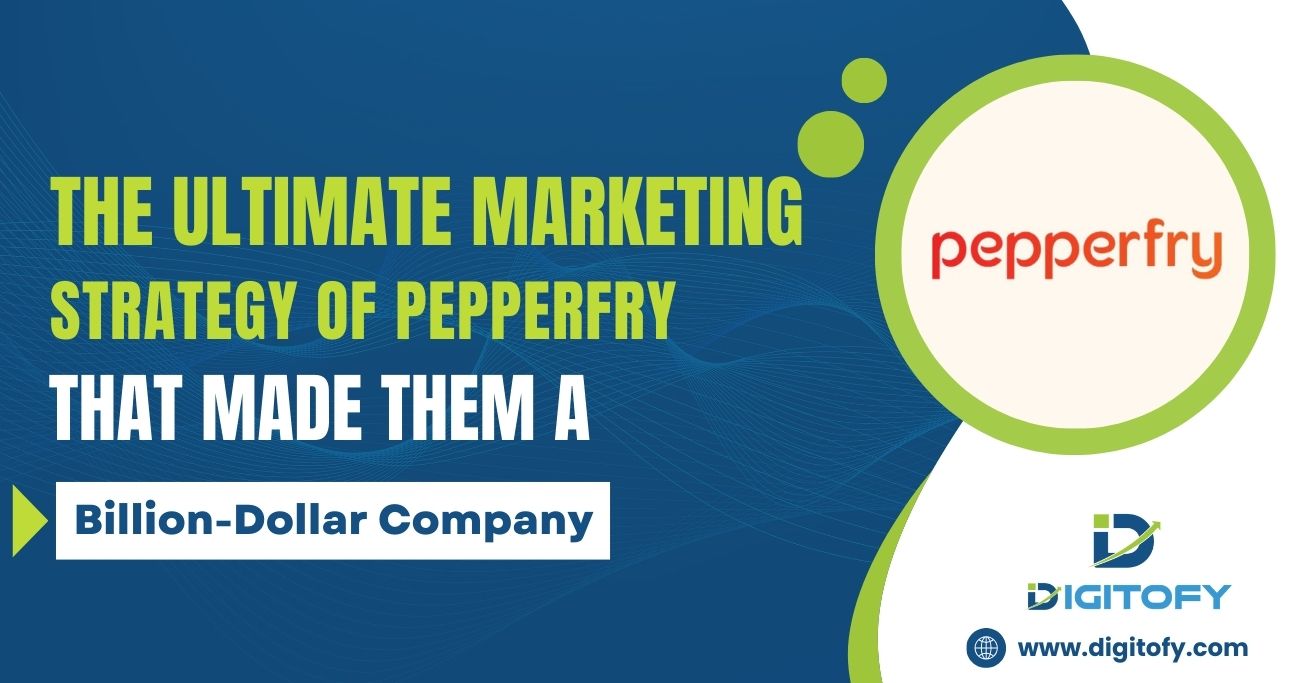The Ultimate Marketing Strategy of PepperFry That Made Them a Billion-Dollar Company
The Indian furniture market has seen seismic shifts in the past decade, with the entrance of e-commerce players like PepperFry. This Bengaluru-based startup has captured the imagination of Indian consumers seeking personalized, high-quality furniture without the hassles of brick-and-mortar stores.
In just under a decade, PepperFry has become a dominant force in furniture e-commerce through smart marketing tactics across digital, partnerships, influencer engagement and more. Their comprehensive marketing strategy provides key lessons for other e-commerce brands looking to create a distinctive brand and carve out a niche.
About PepperFry: The Backstory
Founded in 2012 by Ambareesh Murty and Ashish Shah, PepperFry sought to tap into the largely unorganized $15 billion Indian furniture market. The founding team identified three major consumer pain points that typical furniture buying journeys posed:
Lack of transparency and product quality assurances Long waiting times for customized orders Scarce options to view, test and buy furniture Their e-commerce model allowed consumers to browse furniture by style, material and budget filters, along with buying readymade options or getting customized furniture made. PepperFry partnered with merchants and artisans to have a wide assortment of furniture that matched contemporary Indian aesthetics and tastes.
Besides the value proposition to consumers, PepperFry also focused on supplier relationships by streamlining inventory and order management. This allowed small furnishing vendors, carpenters and upholstery experts to scale up through reaching pan-India audiences via the platform.
What’s New with PepperFry?
Currently, the brand has a vast catalogue of products across styles ranging from urban chic to royal colonial to minimalist and industrial. It serves as a one-stop destination for all furniture, decor and accessories for every room and space.
Some recent developments at PepperFry:
- Launch of PepperFry Manors: a premium designer furniture line crafted from high-quality materials by master artisans. This targets the luxury buyer with premium pricing.
- Expanded offerings in outdoor, office and kids furniture – fast-growing segments.
- Partnerships with interior designers, architects and decorators to co-create designer collections and share their portfolio on the platform.
- Augmented reality feature allowing buyers to visualize furniture in their actual living spaces prior to purchase.
- Launched consultation services with in-house designers to aid buyers with interior design advice.
Also read : How Louis Philippe Acquired 20% of the Apparel Industry by its Secret Marketing Strategy
Buyer Personas
PepperFry has two broad target audience profiles:
- Young urban professionals
This typical PepperFry customer is aged between 25-35 years old, likely married with kids. They are well-travelled and exposed to global design influences and aspirational lifestyles.
With high disposable incomes but constraints of time, space and in-person shopping hassles in cities, they prefer the personalized experience PepperFry offers for their homes.
They have defined tastes and sense of aesthetics and want good value from trusted brands. They make decisions jointly with spouses and sometimes with kids too for children’s room furniture.
- Business owners/companies
The B2B audience for PepperFry comprises of business owners, corporate professionals, architects and interior designers outfitting offices, restaurants, hotels etc.
They seek out PepperFry for the reliability of quality supplies, curated designs suiting commercial spaces and business-friendly services like quotes, invoices etc. Brand perception and aesthetics aligned to their company’s values are key purchase drivers.
PepperFry’s Marketing Mix: The Secret Spice
PepperFry has all 4 Ps of marketing – product, price, place and promotion – down pat, integrated seamlessly to entice and excite furniture lovers.
Product Strategy
True to being a digital-first brand, PepperFry has exemplary product presentation and taxonomy. Buyers can discover products via:
- Lifestyle Needs: Follow feature curations based on style preferences like Mid-Century Modern, Industrial, Bohemian etc.
- Budget: Easily filter by pricing slabs
- Brands: Search by brand affinity
- Design Trends: Discover trending designs like tropical chic or eclectic maximalism
- Bestselling: View most popular furniture across the site
They also showcase designer collections clearly citing the collaborating designers. This allows buyers to find products perfectly matching their personality and spaces.
Another innovation is their 3D viewing capability and AR feature to see products in context of actual living spaces prior to purchase – a key conversion driver.
Pricing Strategy
PepperFry targets value-driven buyers looking for fairness between price and quality. Their good-better-best pricing approach offers:
- Entry-level readymade furniture with basic designs focused on cost savings and value
- Mid-segment curated lines balancing aesthetics with reasonable pricing
- Premium designer collections for discerning luxury tastes
Clear pricing policies around taxes, shipping costs and inclusions aid transparency. Regular promotions and sales events also make pricier furniture more affordable. Their membership program gives access to special prices and exclusive product launches.
Also read : BMW Marketing Strategy: How The Ultimate Driving Machine Sold 9580 Cars & 10% Growth in 2023
Place Strategy
As a digital native, PepperFry sells across India via its user-friendly website and mobile app. Self-service functionality minimizes assisted selling costs.
For deliveries and installation, PepperFry trains specialized personnel who ensure flawless experiences. This avoids dependency on third-party logistics.
Through its channels, PepperFry cuts cycle times and intermediaries substantially compared to traditional furniture sellers. This allows faster turnarounds at lower costs and competitive pricing power.
Promotions Mix
PepperFry follows an omnichannel promotions strategy encompassing:
Digital Marketing:
Search, social, display ads targeting defined audiences. Content marketing highlighting inspirational stories, style ideas and trend reports. Retargeting visitors. Active engagement for leads and sales via chatbot and web push notifications.
Partnerships & Influencer Engagement:
Tie-ups with real estate developers, leading magazines and portals. Also history of working with influencers, bloggers and designers for co-created collections and sponsored content. Helps drive brand perception and purchase intent.
Traditional Media:
Leveraging TV, print and radio selectively for brand building during festive seasons or major campaigns only. Digital has a wider reach at lower costs.
Growing through SEO
PepperFry utilized search engine optimization organically to grow its platform and brand. By:
- Optimizing site architecture and product catalogue taxonomy to make items easily searchable
- Tagging products comprehensively with relevant keywords, materials, style names
- Creating thousands of pages of lifestyle and trend-based content matched to buyer queries
- Generating 45+ lakh monthly traffic via 2+ lakh SEO-driven keywords
- Achieving ~84% organic visibility proving the strength of its solid metadata foundation
This strategy cut paid acquisition costs while building strong brand awareness and trust via unbiased search rankings. It tapped exact user intent for furniture-related needs, allowing PepperFry to engage high-potential leads.
Competitor Analysis
The furnishings category has players like HomeTown, Urban Ladder and IKEA jostling for market share. But PepperFry holds first mover advantage along with scale, product assortment, brand perception and service levels.
Some PepperFry Advantages Over Key Competitors:
vs Urban Ladder:
- Wider range across styles and price points
- Smoother omni-channel buying experience
- Loyalty rewards program
vs IKEA
- Localized catalogue suited for Indian aesthetics and spaces
- Purchase journey in native language vs IKEA’s English
- Comparable quality at average 15-20% lower price points
vs HomeTown:
- Seamless online purchase process
- Modern and youthful communication vs HomeTown’s traditional outlook
- Customization services in more categories like upholstery, mattresses etc
Winning Marketing Takeaways
Key aspects of PepperFry’s customer-centric marketing approach that drive its market leadership:
- Sharp focus on product quality and depth even while rapidly scaling up
- Hyperlocalization across language, aesthetics and pricing
- Investments in digital channels for experience and personalization
- Partnerships expanding reach within target audience brackets
- Building brand on pillars of transparency, quality and service culture
With these sustained efforts, PepperFry revolutionized Indian furniture buying over the past decade. Their marketing strategy will inspire emerging D2C challenger brands across sectors to create delightful customer journeys that convert into lifelong brand love!
Related Blogs:
Achieving 15% Market & 8000+ Crore Revenue by “NEROLAC” with Disrupting Marketing Strategy
ITC Unique Marketing Strategy That Made it into $80 Billion Group
Frooti’s Unstoppable Marketing Strategy That Made Parle Biggest Beverage Leader in 2000’s
MS Dhoni and Dream11: Unravellig the Marketing Strategy of Top Fantasy App of India
How Peyush Bansal’s Marketing Strategies Made Lenskart The Most Lovable Brand?

.webp)

